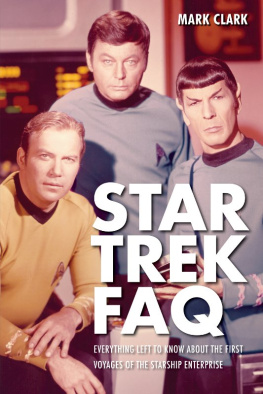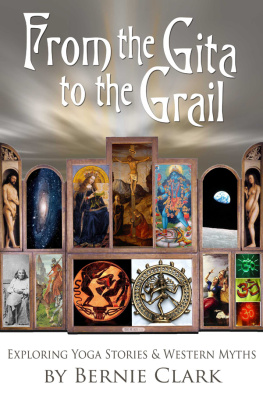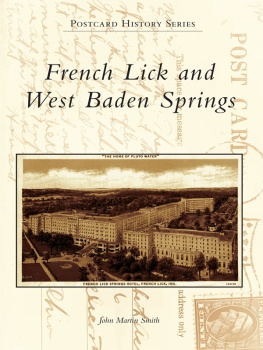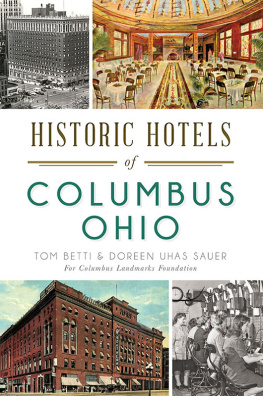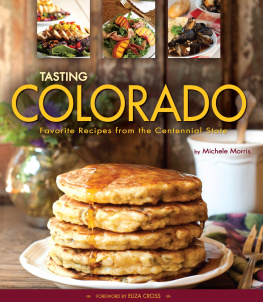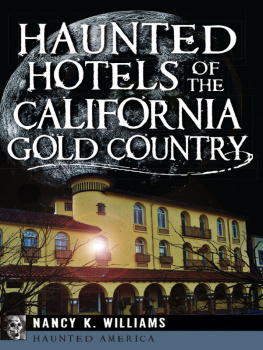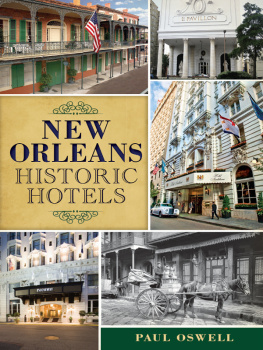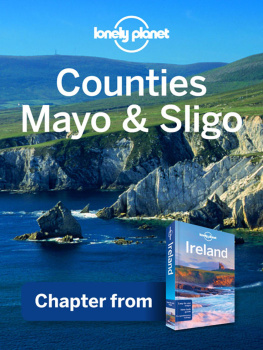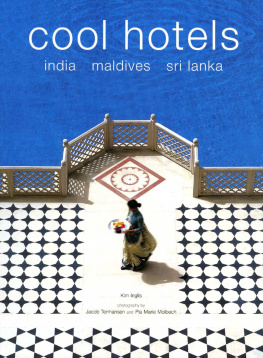

Published by The History Press
Charleston, SC 29403
www.historypress.net
Copyright 2011 by Alexandra Walker Clark
All rights reserved
First published 2011
e-book edition 2012
ISBN 978.1.61423.387.9
Library of Congress Cataloging-in-Publication Data
Clark, Alexandra Walker.
Colorados historic hotels / Alexandra Walker Clark.
p. cm.
print edition ISBN 978-1-60949-301-1
1. Hotels--Colorado--History. 2. Historic buildings--Colorado. 3. Architecture--Colorado--History. 4. Colorado--History, Local. 5. Colorado--Biography. I. Title.
TX909.C53 2011
917.8806--dc23
2011018251
Notice: The information in this book is true and complete to the best of our knowledge. It is offered without guarantee on the part of the author or The History Press. The author and The History Press disclaim all liability in connection with the use of this book.
All rights reserved. No part of this book may be reproduced or transmitted in any form whatsoever without prior written permission from the publisher except in the case of brief quotations embodied in critical articles and reviews.
For Wendell C. Walker, who taught me the love of western travel.
With special thanks to:
Elizabeth Dixon
Coy Gehrig, Denver Public Library Becky Le Jeune Liam Moskowitz Jeff Christlieb Bill Moskowitz, Road Warrior
CONTENTS
INTRODUCTION
For more than 150 years, Colorado has beckoned, and people have responded, some drawn to its beauty, some seeking fortune and some hoping to reclaim health. Colorado has welcomed them allproud and wealthy, humble and hopefulextending its majestic arms to incomers of every stripe. Even before the silver booms and gold rushes that built the mining towns, people came to discover Colorados high peaks, the healing waters of its abundant hot springs and its rich hunting and fishing resources.
Some were drawn by the earth itself, seeking land to develop agriculturally. Many ranches began to promote their properties as guest ranches to compete with hotels and boardinghouses. Enter the early version of the dude ranch.
The nineteenth century was a time of building, of breaking new ground. Settlements were established on the windblown plains and above timberline. The promise of new land and its opportunities brought to Colorado those who scarcely could afford to risk their futures, yet they were not timid or afraid of work. These were miners, cowhands, laborersrisking all for the chance to better their lives. They were settlers, tourists and fortune-seekers, and a more diverse lot could not have been gathered. But they all needed shelter.
Enter the modest entrepreneur. These lodge keepers seldom had great means, yet they were willing to risk it all. Some might have obtained loans from obliging banks, monies that they sank into modest hotels or boardinghouses in hopes of becoming successful business owners. A surprising number of these were women, often widowed or unmarried, who seized the opportunity to establish themselves on par with male counterparts. To own a hotel was to demand respectnot an abundant commodity for women in those days, even back East.
Sometimes a husband and wife might make such a venture together, and as their enterprise succeeded, they would acquire a second hotel, the man running one operation and his wife the other. In these challenging circumstances, families had to stick together.
Note: An asterisk by listing indicates businesses still in operation.
EASTERN COUNTIES
Eastern Colorado seldom drew people for its scenic beauty, as did the mountains and hot springs. While those who settled the plains were primarily farmers and ranchers, there were also businessmen, who saw an opportunity to operate stores and offer services. Every new business drew drummers, or traveling salesmen, who required rooms for themselves and their wares. With the smaller communities growth came the need for teachers and other professionals, who also required temporary housing.
Hotels struggled on this meager fare, and many did not last long. The settlers and businesses that did survive in eastern Colorado heroically battled drought, heat, isolation, ravenous insects, frequent tornados and the housekeepers bane, warm Chinook winds that repeatedly blew fine layers of dust into every crevice. But the people of eastern Colorado are a hardy lot, and their perseverance has paid off in the permanent communities that today dot the plains like welcome oases.
BACA COUNTY
Baca County was created by the Colorado legislature in 1889 from portions of Las Animas County. It is in the southernmost eastern corner of the state, named for Colorado territorial legislator Felipe Baca.
Springfield
Springfield began officially on April 12, 1887, so named because most of its residents had lived in Springfield, Missouri. One of the first commissioners was Frank Tipton, whose original eighty acres are believed to have been the original town site. With the establishment of a courthouse, a jail (mostly for horse thieves) was required.
For some $3,000, the town constructed a two-cell steel cage. The jail opened for business in 1889, and it was reported that the sheriff could not exceed ninety-five cents for feeding prisoners. The areas main crime was horse stealing. The reward for apprehending a horse thief was $25, until one citizen led a campaign to raise that amount to $100 due to the significantly rising number of stolen horses.
Other than that, Springfield was generally quiet, and sometimes a week might pass without anyone coming into town. Storekeepers often stayed at home until a potential customer came into view.
Springfield is located in the southeast corner of the state and is an agricultural community.
JONES HOTEL: Located on Main Street, the Jones Hotel was built prior to 1913.
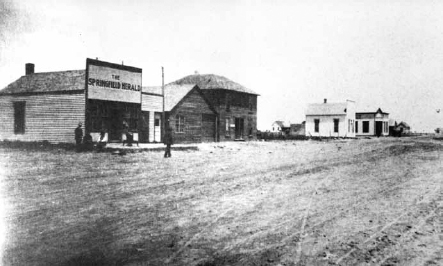
Main Street, Springfield, Colorado. A newspaper office next to the two-story Jones Hotel, 1913.
CHEYENNE COUNTY
The present boundaries of Cheyenne County were established in 1889. It was named for the areas original residents, the Cheyenne Indians, who occupied eastern Colorado before it was settled by whites.
Wild Horse
This town is named for the herds of wild horses that once thundered across these plains, watering at nearby Wild Horse Creek. The entire town burned down in 1917 but was partially rebuilt.
ALBANY HOTEL: Located on Main Street, the Albany Hotel was built prior to 1917. It was razed by the town fire in 1917.
PFALTZGRAFF HOTEL: Built by William H. Pfaltzgraff, this hotel burned down in 1917.
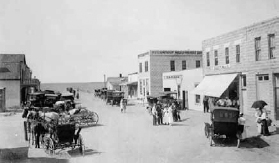
A postcard of Wild Horse, Colorado, in 1917, shortly before the town fire that same year. The Albany Hotel is the stone structure on the right at center.
KIOWA COUNTY
Kiowa County was established in 1889, named for the Kiowa Nation. Kiowa County is the site of the infamous Sand Creek Massacre on November 29, 1864, in which a Kiowa settlement of old men, women and children were ruthlessly slaughtered on Sand Creek by U.S. forces. Initially hailed as a victory against hostile Indians, within months, congressional inquiries disclosed the outrage that still remains a dark blot on the nations historical record.
Next page


